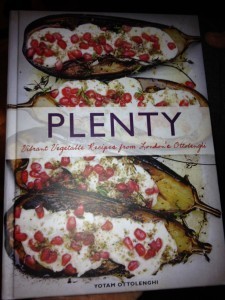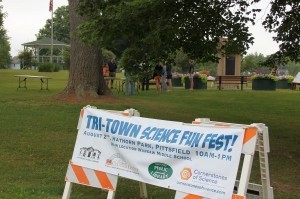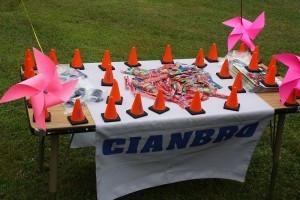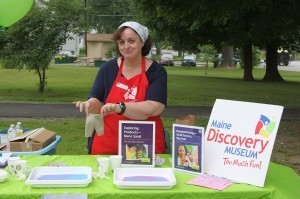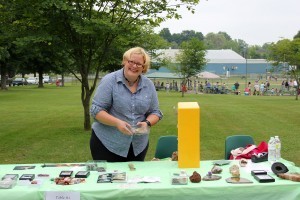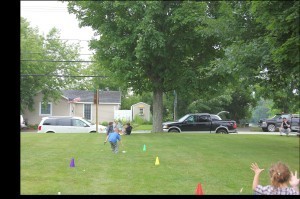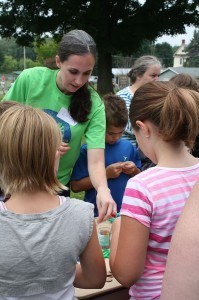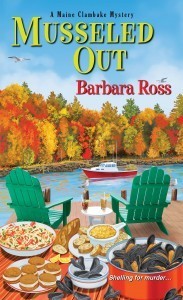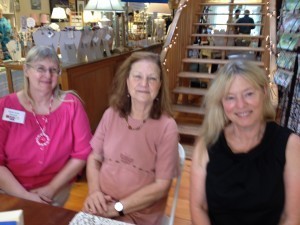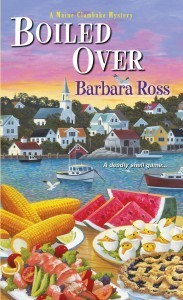Lea Wait's Blog, page 314
August 8, 2014
Intuition
Vicki Doudera here, living the Maine summer reality of working plus trying to enjoy the many visitors who come up to our state for their vacation.
Our guests last night for dinner here in Camden were our friends Patty and Bill, who live outside of Philadelphia and are here for a wedding in Stockton Springs.
Patty’s a nurse and Bill is a police chief — which naturally intrigues my crime-writing mind.
Last night we spent some time talking about intuition, and how it factors into decision making. Bill shared a story of an officer in his department who, after using force to bring down a suspect, said the guy made his “hair stand on end.”
Surely that is as good a feeling as any to intuit that someone is dangerous, but as Bill explained, it is not a good reason for a law enforcement officer to use force.
In talking with the officer, he discovered there were many almost subconscious details that led to the feeling, and those were more in line with what the department’s files needed. (And by the way, the suspect really was a truly bad guy.)
But it made me think about the times that I have been guided by intuition, and vow to read Blink, which Bill said is an excellent book on the subject.
When has your intuition come into play this summer? Have you listened to it, or ignored it?
August 6, 2014
Pet Peeves
Kaitlyn Dunnett/Kathy Lynn Emerson here, musing about pet peeves (not to be confused with peevish pets, which is the topic for an entirely different blog). I’m talking, of course, about the pet peeves we have as readers. We all have them—things that drive us nuts when we come across them in a novel. They range from petty annoyances like typos that you can skip over without too much difficulty to howlers that pull you out of the story and have you fighting the desire to throw the book across the room.
I’m especially picky when I’m reading mysteries set in the times and places with which I am most familiar. For Kaitlyn that’s present-day Maine. For Kathy, it’s sixteenth-century England. It is some consolation that books are generally better at getting things right than movies and television, but not much.
So—novels. What are my personal pet peeves?
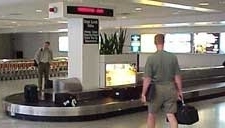 In novels set in today’s Maine (or a reasonable facsimile thereof) it’s scenes set in real places the author has obviously never visited. I remember one description of Portland International Jetport, supposedly as it was when the novel was written (awhile ago now, but “present day” at the time), in which a huge issue was made over the fact that if a character didn’t have her luggage claim ticket she wouldn’t be able to collect her suitcase. Huh? I’ve flown out of Portland at least once a year for more than three decades now and I’ve never seen anyone at the luggage carousels checking baggage claim stubs. I know—picky, picky, picky—but that detail pulled me right out of the story and left me mistrustful of the details used in the rest of the book.
In novels set in today’s Maine (or a reasonable facsimile thereof) it’s scenes set in real places the author has obviously never visited. I remember one description of Portland International Jetport, supposedly as it was when the novel was written (awhile ago now, but “present day” at the time), in which a huge issue was made over the fact that if a character didn’t have her luggage claim ticket she wouldn’t be able to collect her suitcase. Huh? I’ve flown out of Portland at least once a year for more than three decades now and I’ve never seen anyone at the luggage carousels checking baggage claim stubs. I know—picky, picky, picky—but that detail pulled me right out of the story and left me mistrustful of the details used in the rest of the book.
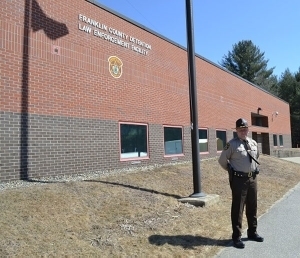 Law enforcement errors are especially grating. If the scene is a fictional town or village (or unorganized territory) the writer has some leeway, but in Maine a sheriff is always an elected county official who rarely investigates crimes himself. A large town or a city would have its own police department. A small town would be more likely to make do with a town constable. The state police patrol huge rural areas and they are the ones who take over the investigation on all homicides except those that take place in Maine’s largest cities. As for jails, that’s a hot button issue where I live, in Franklin County, and in some other Maine counties, as well. We once had our own jail. Now, thanks to a state-mandated reorganization of corrections facilities, prisoners have to be transferred, at considerable expense, to jails in other counties after only a brief stay in the local “detention center.”
Law enforcement errors are especially grating. If the scene is a fictional town or village (or unorganized territory) the writer has some leeway, but in Maine a sheriff is always an elected county official who rarely investigates crimes himself. A large town or a city would have its own police department. A small town would be more likely to make do with a town constable. The state police patrol huge rural areas and they are the ones who take over the investigation on all homicides except those that take place in Maine’s largest cities. As for jails, that’s a hot button issue where I live, in Franklin County, and in some other Maine counties, as well. We once had our own jail. Now, thanks to a state-mandated reorganization of corrections facilities, prisoners have to be transferred, at considerable expense, to jails in other counties after only a brief stay in the local “detention center.”
As Kathy, writing historical mysteries set in the sixteenth century, I’m very conscious of the mistakes other people writing about the same period have made because I am trying so very hard not to make the similar goofs myself. A little research could prevent most of the worst ones, the common errors that just keep turning up, even in novels written by people you’d think would know better. These are the historical equivalent of the smell of cordite—errors that are repeated because the writer has seen them so many times in other people’s novels that he/she assumes they’re right and doesn’t bother to check.
 A surprisingly large number of otherwise intelligent, research-savvy authors appear to be unable to grasp forms of address, in particular how to refer to a knight and his lady. It is really not that difficult. It’s Sir Firstname and Lady Lastname. In my Face Down series, Sir Robert Appleton is addressed as Sir Robert and his wife as Lady Appleton, not as Lady Susanna. Not everyone in the sixteenth century got this right, either, but the rule is (and was) that Lady Firstname signified that the woman was the daughters of an earl or higher. Lady Firstname, the Lady Firstname, Lady Lastname, and Lady Title indicate four different levels in precedence in the English aristocracy. I see writers mix up these forms of address in print so often that I frequently go back and check to make sure I’m not the one who goofed.
A surprisingly large number of otherwise intelligent, research-savvy authors appear to be unable to grasp forms of address, in particular how to refer to a knight and his lady. It is really not that difficult. It’s Sir Firstname and Lady Lastname. In my Face Down series, Sir Robert Appleton is addressed as Sir Robert and his wife as Lady Appleton, not as Lady Susanna. Not everyone in the sixteenth century got this right, either, but the rule is (and was) that Lady Firstname signified that the woman was the daughters of an earl or higher. Lady Firstname, the Lady Firstname, Lady Lastname, and Lady Title indicate four different levels in precedence in the English aristocracy. I see writers mix up these forms of address in print so often that I frequently go back and check to make sure I’m not the one who goofed.
This particular problem probably stems from the fact that most people just aren’t fussy about getting it right. They weren’t in previous eras, either. In wills and other documents from the sixteenth century knights’ wives are often referred to as Lady Firstname. For example, “I give unto my sister, my Lady Lucy, my border of upper billiment of goldsmith’s work.” This doesn’t, however, mean that the young woman making the will was using the correct form of address. To make a modern comparison, it is incorrect to continue to refer to Catherine, duchess of Cambridge as Kate Middleton. Does that stop most people (or newspapers or television commentators) from doing so? Nope. Does constant use make it correct? Also a big no. Writers, more than anyone else, should be scrupulous about forms of address, in the same way we are expected to be scrupulous about following basic spelling and grammar rules.
Okay. Getting down off my soapbox now. But this is a post about pet peeves, and boy is that ever one of mine!

the young Henry VIII
The other thing that makes me crazy, when an author is using real people as characters, is if he or she doesn’t bother to do enough research to get the character’s approximate age, actual title if there is one, and the names of his or her spouse and children right. I realize it’s not always possible to be sure a real person was in the right place at the right time for fictional purposes, but these days the basic names, dates, and titles aren’t all that hard to find. In addition to the Dictionary of National Biography, The History of Parliament, and Wikipedia (this last should be used with caution), there’s always my A Who’s Who of Tudor Women to consult.
So, those are my pet peeves. How about you? What things drive you up a wall when you come across them while reading a mystery novel?
August 5, 2014
When a Writer’s Not Engaged in Her Employment . . .
 Kate Flora here, feeling very guilty about today’s blog topic. The truth is that since I finished a book a couple weeks ago, I’ve been having a very hard time staying focused on work. I have plenty of work and it is sitting beside me right now, glaring as only an unedited manuscript can glare, while I’ve been reading cookbooks.
Kate Flora here, feeling very guilty about today’s blog topic. The truth is that since I finished a book a couple weeks ago, I’ve been having a very hard time staying focused on work. I have plenty of work and it is sitting beside me right now, glaring as only an unedited manuscript can glare, while I’ve been reading cookbooks.
They say that if you have a place on the water in Maine, in the summer you will have a lot of friends. Well, yes we do, and yes, we do. And friends, at least in my house, have to be fed. Normally, I have a few signature dishes each summer that I keep in rotation. This year, because I had my head in a book for so long, I’m only now awakening to the fact that vegetables abound, it’s time to fire up the grill, and other people tend to eat three meals a day instead of my distracted two. So I’ve had to jam on my thinking cap and make a couple runs to the grocery store. Otherwise, my guests would find a table well-stocked with books–at our house the bookshelves overflow and we even use stacks of books for doorstops–and very little food.
So what is going to be appearing on the menu this summer, you’re wondering? Do writers cook like 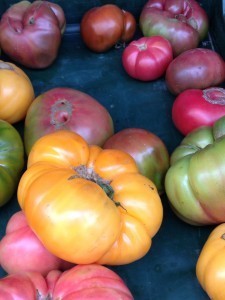 the rest of us? We don’t recall many recipes in Kate’s books, except in the Thea Kozak mysteries. Well, here’s a quick rundown of what the guests were served on a recent weekend:
the rest of us? We don’t recall many recipes in Kate’s books, except in the Thea Kozak mysteries. Well, here’s a quick rundown of what the guests were served on a recent weekend:
Quiche with caramelized onions, roasted asparagus, cheddar and bacon, with fresh cantaloupe and Fran’s quick and dirty mini-blueberry lemon muffins.
Teriyaki-marinated grilled salmon with roasted farmer’s market vegetables and crisp, hot cheese bread.
Cinnamon bread French toast with yogurt and fresh fruit. And yes…more bacon.
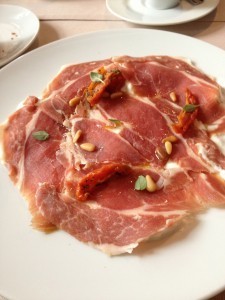 Arugula salad with burrata cheese, prosciutto, and quick pickled nectarines and red onion.
Arugula salad with burrata cheese, prosciutto, and quick pickled nectarines and red onion.
Am I making you hungry yet? Well, because I like to test you and see if you’re really reading this, I’ll make a deal. In your comments, share a quick and dirty summer recipe, and I’ll give you the recipe for anything here that sounds good to you.
Meanwhile, in anticipation of some vegetarian guests, I’m reading a wonderful cookbook called Plenty by Yotam Ottolenghi. And planning to make this wonderful dish: 
Oh. And here’s Thea’s recipe for Quick and Dirty Bluefish Pate:
A chunk of smoked bluefish…about 8 oz.
1 pkg. cream cheese
1 T. bottled horseradish
Lemon juice.
Throw into your food processor and process until smooth. Taste and adjust seasoning. Salt, pepper, more horseradish? If it feels too thick to spread easily, thin with a bit of cream or half-and-half.
Serve with crackers or sliced English cucumbers. You can also make this with Ducktrap Smoked Trout.
Happy eating!
August 4, 2014
Summer Island
 Hello again from Sarah Graves, writing to you from Eastport, Maine, where we are at the absolute tippity-top of the summer season. Sandals, shirtsleeves, seafood on the grill…it’s all here right now, and so are all the people who come to visit and enjoy it. Even the whales are back, eating up the tiny creatures who drift in on warmer tides, and a great white shark was sighted last week, so I guess they’ve found us, too.
Hello again from Sarah Graves, writing to you from Eastport, Maine, where we are at the absolute tippity-top of the summer season. Sandals, shirtsleeves, seafood on the grill…it’s all here right now, and so are all the people who come to visit and enjoy it. Even the whales are back, eating up the tiny creatures who drift in on warmer tides, and a great white shark was sighted last week, so I guess they’ve found us, too.
I was excited to find a Little Library downtown near the fish pier a few weeks ago. Eastport has a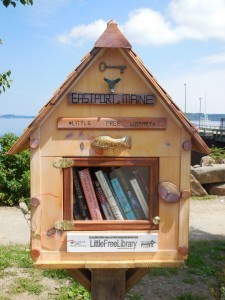 great public library; our librarian is not only right on top of what’s hot and what’s not, she also by some magic manages to acquire it for us. In summer, the sea breeze blows right in through the big open front doors, keeping it cool inside, and in winter the small gas fireplace in the old-fashioned reading room makes the big, soft leather-upholstered chair in the corner a perfect hideout. But…little libraries! Tiny, cunning huts filled with books other people have chosen, to be discovered by you and in return you leave something good for them to read! Oh, what could be better? I love them in theory and in practice, and this one’s especially divine, I think.
great public library; our librarian is not only right on top of what’s hot and what’s not, she also by some magic manages to acquire it for us. In summer, the sea breeze blows right in through the big open front doors, keeping it cool inside, and in winter the small gas fireplace in the old-fashioned reading room makes the big, soft leather-upholstered chair in the corner a perfect hideout. But…little libraries! Tiny, cunning huts filled with books other people have chosen, to be discovered by you and in return you leave something good for them to read! Oh, what could be better? I love them in theory and in practice, and this one’s especially divine, I think.
 Every year the gardens in Eastport seem to get better. For one thing we all get a little better at doing it just from longer practice, and for another this year-after-year soil amendment we are all doing is finally catching up with our soil’s natural tendency, which is to turn back into clay. But we just keep dumping compost on top, and the compost keeps soaking in, and the earthworms eat it a teensy bit faster than the clay-return system can work. There are benefits besides flowers, fruit, and vegetables, too; a few years ago a neighbor planted milkweed, cultivating diligently the weed that rampant land development is crowding out, and this year I saw a beautiful orange-and-black monarch butterfly fluttering through my yard. In my childhood I used to treasure their jewel-like chrysalises (how do you pluralize that, anyway? Is that right, the way I did it?) so I was glad to see the long-absent monarch.
Every year the gardens in Eastport seem to get better. For one thing we all get a little better at doing it just from longer practice, and for another this year-after-year soil amendment we are all doing is finally catching up with our soil’s natural tendency, which is to turn back into clay. But we just keep dumping compost on top, and the compost keeps soaking in, and the earthworms eat it a teensy bit faster than the clay-return system can work. There are benefits besides flowers, fruit, and vegetables, too; a few years ago a neighbor planted milkweed, cultivating diligently the weed that rampant land development is crowding out, and this year I saw a beautiful orange-and-black monarch butterfly fluttering through my yard. In my childhood I used to treasure their jewel-like chrysalises (how do you pluralize that, anyway? Is that right, the way I did it?) so I was glad to see the long-absent monarch.
Downtown Eastport is positively swarming with people. They stroll around gazing in charmed wonder at the sights we see every day, and they gaze at us, too, curious as to how we manage to live here. I don’t blame them; I wonder sometimes how we manage, too, especially in February when a trip to Bangor is both necessary (any kind of medical or dental specialty appointment means a long car ride, for instance) and horrid (50 miles of twisty two-lane followed by 100 more of desolate, icy highway). But for now when winter is just a bad dream, we all agree that in August, Eastport can be heaven on earth.
at the sights we see every day, and they gaze at us, too, curious as to how we manage to live here. I don’t blame them; I wonder sometimes how we manage, too, especially in February when a trip to Bangor is both necessary (any kind of medical or dental specialty appointment means a long car ride, for instance) and horrid (50 miles of twisty two-lane followed by 100 more of desolate, icy highway). But for now when winter is just a bad dream, we all agree that in August, Eastport can be heaven on earth.
August 3, 2014
When Libraries Cooperate
John Clark here, talking about how cool things happen when libraries cooperate (heck even the weather bends to our will). The Hartland Public Library, Newport Cultural Center & Library and the Pittsfield Public Library are in what we’ve come to call the Sebasticook Triangle. We’re all on branches of the Sebasticook River and share mutual patrons from small towns nearby that lack libraries. Joanne Elwell, the childrens librarian at Newport, Lynn Smith, the director in Pittsfield, and I have developed a terrific working relationship over the years. We can pick up the phone, make a call and send a desperate high schooler to one of the other libraries to get that book they have to have for the report due tomorrow. We swap extra books and movies, pass on extra copies, especially of young adult fiction and I take care of the remaining items when they have book sales.
Several years ago, we all became partner libraries with a fabulous nonprofit called Cornerstones of Science, headquartered in Brunswick. (http://www.cornerstonesofscience.org/) Their mission is as follows: “Cornerstones of Science works with libraries to create experiences of science that spark curiosity and foster a deeper connection to the world around us”. Lord knows we need more science-oriented kids in this country, so why not make the experience a fun and inviting one. Cornerstones has helped foster this effort in a number of ways. They provided grant money to expand science-oriented collections in our libraries when the money was available, they worked with us to hatch monarch butterflies (kids loved watching this happen) that were tagged so patrons could track their migration, they worked with Maine astronomers to train library staff in the use of telescopes and gave each member library a dandy one. (Bet you didn’t know you could check out a telescope at the library). On Saturday, August 2nd, they partnered with the three libraries to create an amazing day of fun and learning at Hathorn Park in Pittsfield.
When Joanne got the idea of our libraries putting on an end of the year outdoor festival embracing this year’s reading theme of “Fizz, Boom, Read, we were going to create the hands-on table programs ourselves, using volunteers from each library, but Joanne’s a master at getting people to pitch in who are really creative and do things like this for a living. It didn’t take long for her to get commitments from enough groups to ensure that we’d have a truly fun and engaging day. Alisha Scamman, a new member of the Pittsfield library staff, was dropped into the planning midway through the process, but did a masterful job as she was responsible for logistics the day of the event. She made certain we had chairs, tables and a sound system for our singer, Michael Parent. I was responsible for trash bags and the registration sheets that had staggered assignments so none of the tables would be overwhelmed.
Whenever you schedule an outdoor event in Maine, you have to factor in the possibility of rain. Given the amount we’ve had this summer, this was a big concern, but the staff at the Pittsfield Library lined up the gym at Warsaw School as a backup. The Pittsfield Congregational Church helped out as well by loaning us the extra tables we needed. All of us pitched in with door prizes and as you can see by the stuff on the prize table, we sent a bunch of kids home with cool goodies, including science kits, new fishing outfits, a nice pair of binoculars, A Pepsi-themed beach towel and an uber-cool Mountain Dew hoodie.
Although the forecase called for a 30% chance of showers, we decided to go with the outside location and were rewarded with a perfect day. Moderate temperatures, a light breeze and a high overcast sky made conditions ideal for kids and parents/grandparents to enjoy learning about science in fun, hands-on ways. Our presenters were set up and ready to go as the ten a.m. starting time approached. One of my worries was that we’d have all these great experiences and nobody would come. That worry evaporated quickly and by the time we finished registering everyone, almost all of the 80 forms were used. If you figure that there were one or two adults with each kid, that means we probably had close to 200 people attend, a great turnout for our first joint effort outside.
We had some great things for kids to explore. I hung out at the L.C. Bates Museum Rocks and Minerals table, showing kids how to write their name with a rock (raw graphite) and encouraging them to choose a couple polished rock samples to take home. If you’re ever looking for a great and economical program related to nature or science, you can’t do better than what the staff at the L.C. Bates Museum (http://www.gwh.org/lcbates/LCBatesMuseum.aspx) offers. We’ve had them come to do two programs for each of the past three summers at the Hartland Public Library and they do a stellar job.
Cianbro was there with a hands-on engineering activity, kids were able to build a balloon-powered car with the Children’s Discovery Museum of Augusta, experiment with Nano Science with the Maine Discovery Museum in Bangor, discover the science of bubbles with the Girls Scouts of Maine, partake in aerospace engineering and Maine lake watershed activities with UMaine students which included building soda-straw rockets and see how far they could get them to go after launching them, (some kids were so good I think NASA might have recruited them on the spot). Costumed folks were there handing out discount coupons for treats at the new Sweet Frog, Scoop, and Cookie franchise in Waterville.
Cornerstones of Science helped with things like great promotional banners which have removable dates, so we can use them next year. Our next step is to have a followup meeting and see what our evaluations tell us. We asked kids four simple questions: What rocked, what was lame, will you come if we do this again next year and what do you want to do if you do come next year.
No event like this can happen without capable volunteers. My wife Beth, got the helium balloons and was our official photographer, Lydia Elwell helped with registration and the prize table, The Kimballs (David, Kathy and Audrey) helped move tables and chairs, set up and pick up after the event and Karen McGrady moved about all day, lending a hand when and where needed. There were other volunteers from Pittsfield who helped out, but I wasn’t able to get their names.
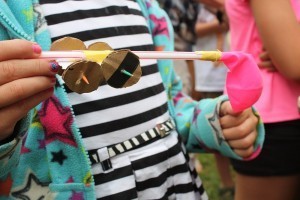
It gets great mileage!
Looking back, I don’t think this could have gone any better. I saw a lot of happy and excited kids enjoying fun learning experiences and it seldom gets any better than that.
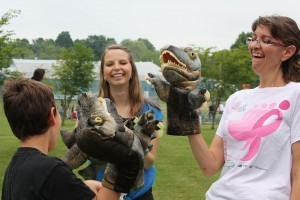
Alisha and Holly from the Pittsfield Public Library with dino puppets courtesy of L.C. Bates
August 1, 2014
Weekend Update: August 2-3, 2014
 Next week at Maine Crime Writers there will be posts by John Clark (Monday), Sarah Graves (Tuesday), Kate Flora (Wednesday), Kaitlyn Dunnett (Thursday), and Vicki Doudera (Friday).
Next week at Maine Crime Writers there will be posts by John Clark (Monday), Sarah Graves (Tuesday), Kate Flora (Wednesday), Kaitlyn Dunnett (Thursday), and Vicki Doudera (Friday).
In the news department, here’s what’s happening with some of us who blog regularly at Maine Crime Writers:
Barb: There’s a cover for Musseled Out, the next book in the Maine Clambake Mystery series, due out May 5, 2015. What do you think?
As part of the Acadian World Congress: Vaughn C. Hardacker will be selling/signing his novel, SNIPER, during the Maine-on-Main days in Van Buren (August 9 & 10). Stop by if you’re in the area.
Recently, we blogged about Thirteen Reasons Maine is the BEST Place to Live. But we didn’t give you all thirteen, because we decided to space them out and bring you smaller tastes of what makes Maine great in our weekend updates. So for this week, we offer:
Real Small Town Life: Main streets with local stores, just about every town has an art gallery, an antiques shop, a craft shop, and a farmers’ market … where you can buy artisanal cheeses, free-range chickens (and their eggs), local beers, wines, gins and vodkas along with baked goods, jam, fresh vegetables and Maine-made cheese. Dogs are welcome, kids abound, and sometimes someone even plays the ukulele.
In the summer, Maine Crime Writers occasionally leave their desks. Here are Kate Flora, Kathy Lynn Emerson/Kaitlyn Dunnett, and Dorothy Cannell at the Beyond the Sea Book Festival in Lincolnville last Saturday. A perfect taste of small town life in a gift shop full of books, cards, jewelry, scarves and other irresistible things.
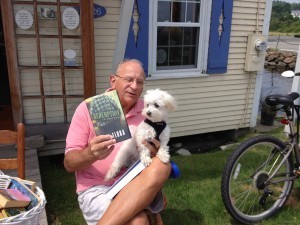
A man called Dave, a dog named Reny, and a book by Kate
Lea Wait: And sometimes we combine art with writing! Thursday, August 7, I’ll be speaking in Damariscotta (route 1 just north of business route 1) at the River Arts Center on “Living and Writing in Maine.” Gee — sounds like a good blog topic! I’ll be speaking at 7 p.m., and look forward to answering lots of questions, and signing some books.
An invitation to readers of this blog: Do you have news relating to Maine, Crime, or Writing? We’d love to hear from you. Just comment below to share. Don’t forget that comments are entered for a chance to win our wonderful basket of books, and the very special moose and lobster cookie cutters.

Pothole in Camden, Maine shaped like the state of Maine. Is there a message here?
And a reminder: If your library, school, or organization is looking for a speaker, we are often available to talk about the writing process, research, where we get our ideas, and other mysteries of the business. Contact Kate Flora: mailto: kateflora@gmail.com
July 31, 2014
Lobster Deviled Eggs
Boiled Over, the second book in the Maine Clambake Mystery series takes place in August, so I thought I’d share one of the recipes in the book–Lobster Deviled Eggs.
The eggs didn’t start out with lobster in them.
Boiled Over opens on Founder’s Weekend in Busman’s Harbor, Maine. My protagonist, Julia Snowden’s family takes a picnic to the waterfront park, where they listen to live music and watch fireworks. Her mother makes deviled eggs.
Julia’s mother, Jacqueline, is a terrible cook. That’s why Julia’s sister, Livvie, is such a good cook–self defense. But it’s also part and parcel of Jacqueline’s outsiderness. Her family feeds 400 happy people a day, so for the rest of the Snowdens, cooking and eating are communal and joyful activities. For Jacqueline, fixing meals is a chore, and one best accomplished alone.
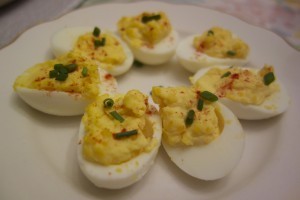 Like a lot of terrible cooks, Jacqueline has one signature dish that she brings to every “party, potluck, picnic or other powwow,” the family is invited to where bringing a plate of food is required. I picked deviled eggs for Jacqueline for two reasons. 1) I like them a lot, and 2) I have a sister-in-law who makes great ones, so I thought getting a recipe would be easy. Believe me, when you write culinary mysteries, this is a huge consideration.
Like a lot of terrible cooks, Jacqueline has one signature dish that she brings to every “party, potluck, picnic or other powwow,” the family is invited to where bringing a plate of food is required. I picked deviled eggs for Jacqueline for two reasons. 1) I like them a lot, and 2) I have a sister-in-law who makes great ones, so I thought getting a recipe would be easy. Believe me, when you write culinary mysteries, this is a huge consideration.
It turns out, my sister-in-law doesn’t actually have a recipe. She’s been making the eggs for so long, she just kind of does it. But my husband stepped up and figured one out. As we usually do, we made the recipe, and tasted the eggs, took pictures and talked about how to describe them. When I handed the book in in September 2013, the eggs were included–without lobster.
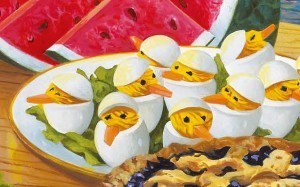
People always ask about the egg chicks. They aren’t in the book or part of the recipe. They came from the cover artist. But I absolutely love them.
Then two things happened. 1) I kept collecting food pictures on my Pinterest inspiration food board, and it seemed like more and more of the deviled egg recipes I found were for lobster deviled eggs. I started thinking, of course Jacqueline makes lobster deviled eggs. She has so much access to lobster, her friends would probably be pissed off if she showed up for parties with a non-lobster related dish.
And, 2) the recipe called for eight hard-boiled eggs. But because the yolk stuffing was mounded in the egg white, only six of the eggs got stuffed–i.e. twelve halves. When the edits for the book came back, the copy editor was very consternated about this. “What do you do with the other four halves?” she demanded to know.
I don’t know, throw them out? My husband said, “Eat them.” Then I asked him, “If we put lobster in the deviled eggs, would it fill up all the egg whites?” Et voila, two birds. One stone. Problem solved.
Here’s the recipe as it appears in Boiled Over.
Jacqueline’s Lobster Deviled Eggs
(The secret’s in the horseradish and smoked paprika.)
8 eggs
3 Tablespoons mayonnaise
1 Tablespoon prepared horseradish, drained
1 teaspoon cider vinegar
1 teaspoon Dijon mustard
8 ounces cooked lobster meat, chopped.
smoked paprika
snipped chives
Place eggs in saucepan covered with water. Bring to boil and remove from heat. Rest in water for 10 minutes. Rinse with cold water. Add ice and allow them to cool. Peel eggs and slice in half lengthwise. Scoop yolks into bowl. Add mayonnaise, horseradish, vinegar, and mustard and mash together. Gently fold in lobster meat. Spoon back into the egg white halves. Garnish with paprika and chives. Chill before serving. Serves 4-6.
The Chill of Night Redux
James Hayman: Recently my second thriller The Chill of Night was re-released by Harper Collins. Unlike it’s original release in which it sank unnoticed like a stone, the second incarnation of Chill is doing very well. Yesterday it hit #19 in Barnes & Noble’s Nook store and was the 6th best selling crime book ahead of such luminaries as James Patterson and Harlan Coben but behind the latest Jack Reacher adventure and, sad to say, behind the ever popular 50 Shades of Grey.
Like all my books, The Chill of Night is a character driven thriller. At its core, Chill is a story of betrayal. Betrayal of both the innocent and not-so-innocent at the hands of people they should have been able to trust.
One of the key characters in the book is a lapsed Catholic priest named John Kelly. Kelly, who is gay, was sexually abused by a priest when he was a young teenager. An idealist, Kelly himself later entered the priesthood in the midst of the abuse scandals, ostensibly in the hope that he could best help reform the institution from the inside out. However, after a few years, he left the Church, disgusted by the institution’s ongoing refusal to properly deal with and punish pedophile priests.
Kelly’s next project was to found Sanctuary House, a non-profit in Portland, Maine whose mission was to provide shelter and support for runaway teens. Most of the kids who came to Sanctuary House ran away from their families because they were suffering physical and sexual abuse at the hands of fathers or other family members who, as Kelly insists, they should have been able to trust but who in the end betrayed them.
The plot of The Chill of Night swirls around the question, did Father Jack, the beloved, trusted and revered protector of teens, kill Sanctuary House board member and attorney, Lainie Goff, to keep her from revealing that Kelly was himself sexually abusing the same teens who had come to him for protection from the abusers in their own families?
One of the inspirations for creating the character of Father Jack grew out of the sordid and complex story of Father Bruce Ritter, the founder of Covenant House, a much larger real life version of Sanctuary House.
When Ritter was a young Franciscan priest in the 1960’s, he left his post teaching Theology at Manhattan College and rented a large apartment in New York’s East Village. When a group of homeless teens knocked on the door seeking shelter from a blizzard, Ritter took them in and this apartment became the original Covenant House.
At the time the East Village wasn’t the chic neighborhood it has since become. Rather, it was a slum that attracted the down and out, and harbored, within its crumbling tenements, an assortment of derelicts, petty criminals, drug dealers, prostitutes and pimps. Father Ritter continued to use this apartment, and eventually others, to provide shelter and support for a population that had previously fallen through the cracks: runaway teens, both male and female, who’d fled their homes and come to New York where most had fallen into lives of prostitution and heavy drug use.
Over the next two decades Covenant House grew into one of the country’s largest non-profits dedicated to supporting homeless youth. According to Ritter’s 1999 obituary in the New York Times, “Covenant House had grown to include a large shelter on West 41st Street, an outreach van with social workers who encouraged children to come in from the streets, and rooms for young people with AIDS, early in the epidemic. It spent three times more money on runaways than the Federal Government did.
And Bruce Ritter was the force behind it — a charismatic, eloquent, persuasive, ambitious man who won the backing of the city’s most powerful politicians and deep-pocketed corporations.”
One of these “deep-pocketed corporations” was Young & Rubicam, the large New York advertising agency where, for nearly twenty years, I served as a senior creative director. During my time at Y&R, I met Ritter a number of times and frequently listened to him speak on behalf of the charitable institution he’d created.
Because of this connection, I clearly remember the uproar, in December of 1989, when Ritter was accused by one of the teens he had once helped of offering his wards money in exchange for sex. Other former Covenant House residents stepped forward accusing Ritter of the same thing. He was also accused of diverting Covenant House funds for personal use.
Though nothing was ever proved, Ritter resigned as the director of Covenant House and retired to a life of quiet contemplation in upstate New York where he died in 1999. I should mention that Covenant House is still a thriving institution. With assets of over $90 million and houses in 22 cities throughout the US, Canada and Latin America, it is today the largest privately funded agency in the US providing support services to homeless and runaway youth.
Did Ritter actually do the evil things he was accused of? We’ll never know. Did John Kelly, my fictional version of Ritter, kill Lainie Goff to cover up his crimes? That’s a spoiler so I’m not telling. To find out you’ll have to read The Chill of Night.
July 29, 2014
Lizzie Borden Took An Axe…
Vaughn C. Hardacker here: In 2009 I was laid off from the last of many hi-tech jobs and being single (my wife of thirty-six years passed away after a brief but valiant battle with cancer) I decided that the time was right for me to do what I always wanted to do…write full time. A quick look at my financial position made it obvious that I could no longer afford to live in the Boston/Southern New Hampshire area, so I decided to return to my roots…Aroostook County.
Soon after relocating to Caribou, I became interested in tracing my family tree. As a teenager, I always thought that I was descended from a long line of fishermen from Nova Scotia. What I learned was quite the opposite. My great-grandmother was a descendent of Richard Borden who left England and settled in Portsmouth, Rhode Island. His descendents include: Robert Laird Borden (Prime Minister of Canada and last Canadian Prime Minister to be knighted by the King of England), Sir Winston Churchill, Marilyn Monroe, and Andrew J. Borden—father of Lizzie Andrew Borden. This led me to look inside of Lizzie’s case with more interest than one may normally have. Here is what I learned!
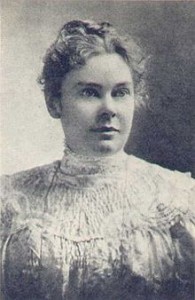 Lizzie Borden took an axe
Lizzie Borden took an axe
And gave her mother forty whacks
When she saw what she had done
She gave her father forty-one
The poem, however inaccurate (she was found not guilty, only nineteen blows were counted, the nature of the murder weapon—thought to be a hatchet; not an axe—and the fact that Abby Borden was her step-mother) has kept Lizzie Borden (my 5th cousin, twice removed) a part of Americana since the murders of her father and her step-mother, Abby Durfee Gray Borden, on August 4, 1892 in Fall River, Massachusetts. But few know little more than the poem. So who was Lizzie Borden and why she was considered the prime suspect in a crime for which she was found not guilty on June 20, 1893.
Lizzie Andrew Borden (July 19, 1860 – June 1, 1927) was the youngest of three daughters of Andrew Jackson Borden and Sarah Anthony Morse. Her mother died shortly after Lizzie’s birth and Andrew married Abby Durfee Gray, who took over the task of raising his two daughters (Lizzie had an older sister Emma Lenora Borden and there was a middle sister who died at the age of two) and running the household. The Bordens were solid upper-middle class and nowhere near the richest family in Fall River as is generally thought. Lizzie grew up in an atmosphere of idle, although not gentile living. She was never to hold a job, although she did volunteer work for church missions, temperance unions and various charities.
Andrew Borden was known to be stingy with a Scrooge-like attitude toward his customers, tenants, and those who borrowed money from him. During her trial, the prosecution attempted to depict Lizzie as a person who would not only kill for an inheritance, but would do so to avenge years of deprivation (both material and psychological) she had endured in her father’s household. There was evidence of friction between the sisters and their father over the way he catered to Abby’s relatives (or so the girls believed). It was during this time that Lizzie stopped calling Abby mother and began calling her Mrs. Borden.
Lizzie was considered a suspect in the killings by a number of police officers from the moment they were notified. At the time of the killings only Lizzie, Bridget Sullivan (the Borden’s domestic servant) and the victims were home. It has been thought that Lizzie murdered her step-mother while Bridget was outside the house washing windows. She later told her father that Mrs. Borden had received a note about a sick friend and she was out of the house. She then encouraged her father to take a nap. Bridget, finished with her chores, went to her room to take a nap. Lizzie said that she then went out to the barn on an errand. According to Lizzie, she returned to the house after hearing a groan, a scraping noise or a call of distress (she related several contradictory stories to the police). Eventually she settled on the story that she went to check on her father and found him slain, his head mutilated.
On August 11th, after appearing before an inquest, she was arrested for the murders. In December, a Grand Jury handed down three indictments against Lizzie Borden: one for the murder of her father, one for the murder of her step-mother, and one for the murder of both. She was removed to a Taunton jail where she remained until her trial in June 1893.
After a thirteen day trial, a jury of twelve, mostly Republican men, average age fifty-three, found her not guilty on all counts. There were a number of firsts in the trial, such as the victims’ skulls being entered into evidence. The one facet that seemed to be over-looked was the complete incompetence of the investigating officers who completely fumbled throughout. As a result, the murder weapon was never found nor were the clothes Lizzie wore, if any, while committing the crimes. Another aspect was over-looked, the sequence of the crimes. The sisters became wealthy women because Abby died before Andrew. Therefore the step-mother’s family was deprived of her estate and, as a legal matter, it fell into Emma and Lizzie’s possession.
At first, public opinion about the verdict was favorable—possibly because it was generally believed that Lizzie would leave Fall River and live someplace where she was less known. She did not, she returned to her home and remained in the city. The absence of closure about the murders caused Lizzie’s and Emma’s position in society to fall. The final blow to her status came when Lizzie (who had a history of stealing) was accused of shoplifting two paintings from a Providence, Rhode Island company. A warrant was never served and the matter was settled privately and Lizzie’s reputation was diminished and she became more isolated.
In 1905, Emma moved out with no public explanation. There is speculation that Emma learned something about the 1892 murders. The sisters never saw nor spoke with each other again.
Lizzie Andrew Borden spent the last twenty-two years of her life an aging spinster surrounded by faithful servants who have never broken their silence. She was quite generous with their salaries and even purchased a house as a residence for some of them.
Lizzie died on June 1, 1927, after suffering complications after a gall bladder operation. Emma died nine days later in Newmarket, New Hampshire. Neither had begotten children so the Andrew Borden branch of the family came to an end.
Lizzie’s infamous name has endured and become iconic, spawning numerous books and at least two movies, one starring Elizabeth Montgomery as Lizzie and a more recent (and I believe more historically accurate) with Christina Ricci in the lead role. Whether or not she committed the murders the unanswered questions continue to fascinate mystery lovers throughout the world.
For more information about Lizzie visit http://www.thelizziebordencollection.com
July 28, 2014
Dialogue …. It’s What Keeps The Story (And My Life) Moving
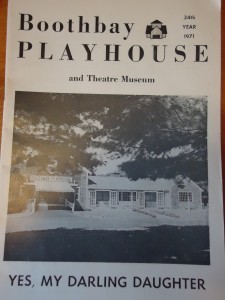 Lea Wait, here. Two (of my eight) grandchildren have been visiting for the past two weeks, and they’ve had lots of questions about … just about everything. As young teenagers, one of their questions was about summer jobs. When I was in high school, had I had one? How did you get a job?
Lea Wait, here. Two (of my eight) grandchildren have been visiting for the past two weeks, and they’ve had lots of questions about … just about everything. As young teenagers, one of their questions was about summer jobs. When I was in high school, had I had one? How did you get a job?
And it got me thinking. When I was fourteen, someone (I honestly don’t remember who) took me to see a play at the Boothbay Playhouse, a summer equity company in Boothbay, Maine. I loved it — and, for, I think, the only time in my life, I wrote a fan letter to the leading actress, Harryetta Peterka. To my surprise (and, I think, perhaps my mother’s embarrassment,) Harryetta shared the note with the two producers at the theatre, and one of them, Jim Wilmot, called me, and asked me if I’d like to usher there. I wouldn’t get paid, would work one evening a week — and would get to see the show for free.
I immediately agreed, and when I discovered that another teenager who lived nearby (an older boy – with a license and a pickup truck) worked there parking cars, I asked Jim if I could usher all five nights the theatre was open each week. I had a ride. And so, for the rest of the summer, I ushered every night, and stood behind the last row in the balcony to listen to every word of every play.
The next summer, Jim made me head usher, which meant I still didn’t get paid, but I called potential ushers and scheduled them, worked every night, and, when intermissions get busy, I sold candy and sodas and coffee, too. The year after that I worked during the day at the Boothbay Register, the local weekly newspaper, but in the evening — yes — you could find me five nights of the week at the Playhouse. Ushering, and listening. And so it continued.
The year after my stint at the newspaper I worked full time (and was paid! $30 a week) during the day at the Playhouse’s ticket booth in Boothbay Harbor, and then got to the Playhouse in time to, of course, usher every night. After that summer I graduated from ushering. I worked at the Playhouse box office. But I stayed every night until every play was over. And working at the Playhouse itself I heard many more lines, many times. The hard-working New York repertory company was performing one play while they were rehearsing a second and learning the lines to a third. The company produced nine plays each summer, from Ibsen to Ionesco to Noel Coward to Neil Simon to Thornton Wilder. All day, every day, I heard dialogue. I learned many of the plays by heart, without trying. I learned which lines got laughs or gasps, and which didn’t. I didn’t realize it, but I was learning to write dialogue.
I wrote my first play when I was in high school. When I went to college, my years at the Playhouse (which continued summers) encouraged me to major in drama as well as English. I wrote plays for children’s theatre as part of my senior thesis. And then … I graduated and looked for a job.
After a number of interviews, as luck would have it, I was interviewed by a public relations manager at AT&T who had attended the Yale School of Drama. He asked me if I had any of my plays with me. A young graduate, just 21, of course I had writing samples. I handed him one of my plays — I think it was about a chipmunk and an owl. (Unlikely though that was.) He sat at his imposing mahogany desk and read several pages. He then handed my play back to me and said, “You can write dialogue.”
“Yes,” I said.
“Then you can write executive speeches,” he pronounced. (I hadn’t even realized anyone but the President of the United States had a speechwriter.) My first speech was for the President of the Western Electric Company – then the manufacturing and supply arm of the Bell System. I was the first management woman in the public relations department. I wrote speeches, videos, films. articles … and went on to directing, producing, writing and “staring” in a daily television program for AT&T employees.
In 1998, many jobs after that, I left AT&T, but I haven’t stopped writing. I still depend on dialogue to move my stories along.
And, yes .. it all started with a fan letter I wrote when I was fourteen, which led to a summer job, which changed what I majored in at college, which led to a corporate career. And I still smile whenever a reviewer praises my dialogue.
Yes, I can write dialogue. I’ve been doing it since high school.
Lea Wait's Blog
- Lea Wait's profile
- 509 followers


